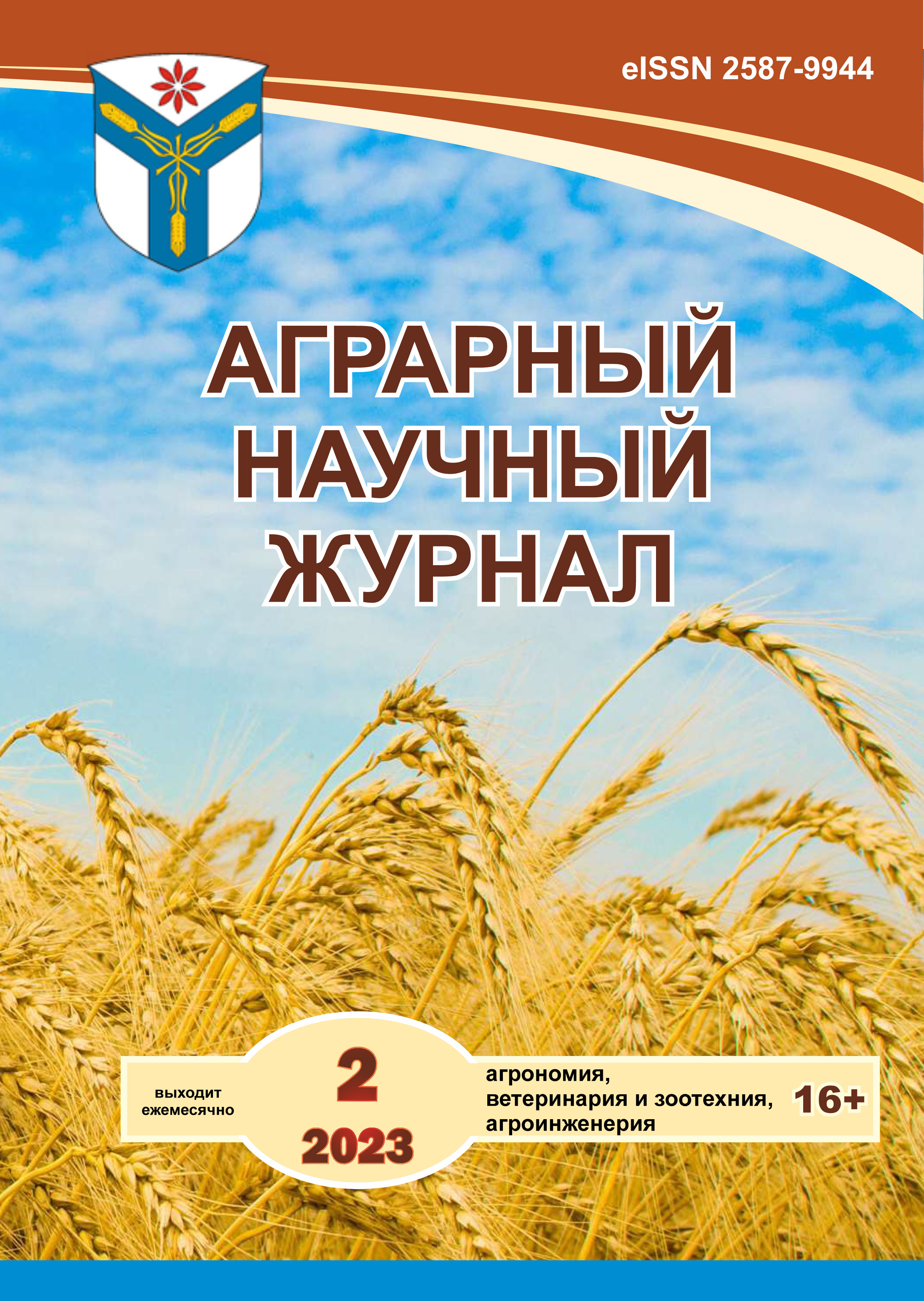Bacteria to stimulate the growth and increase the yield of bread spring wheat in the conditions of the Trans-Ural steppe
DOI:
https://doi.org/10.28983/asj.y2022i2pp60-66Keywords:
Pseudomonas protegens DА1.2, chistalan, nanomet, wheat, phytohormones, droughtAbstract
The paper presents data from three years of field research in the conditions of the Trans-Ural steppe zone. The positive effect of treatment with a strain of bacteria Pseudomonas protegens DA1.2 together with herbicides of different chemical nature (chistalan and nanomet) in drought conditions is shown. Inoculation with bacteria led to an increase in wheat yield under combined stress due to the growth-stimulating effect of bacteria on plants and leveling the toxic effect of herbicides. Treatment with bacteria and herbicides contributed to the accumulation of raw plant mass and stimulating the growth of shoots, maintained high relative water content, and increased the concentration of chlorophyll in the leaves. The introduction of herbicides of different chemical nature had a different effect on the hormonal status of plants. In combination of bacterial treatment with the herbicide nanomet, an increase in the content of abscisic acid (ABA) and a decrease in the level of auxins (IAA) in wheat plant shoots were noted. And when treated with strain Pseudomonas protegens DA1.2 with chistalan, the concentration of ABА in the shoots decreased. The addition of bacteria to herbicides during processing led to an increase in the number of grains in the ear, the weight of grain per ear. The maximum increase in yield relative to the control was observed in variants of joint treatment with bacteria of strain Pseudomonas protegens DA 1.2 with chistalan or nanomet.
Downloads
References
Abdulgani D. Crop Production and Yield Limiting Factors // Journal of Applied Sciences. 2021. No. 6(2). P. 325–349. DOI:http://dx.doi.org/10.52520/masjaps.42.
Contribution of Plant Growth Regulators in Mitigation of Herbicidal Stress / S. Varhney et al. // J Plant Biochem Physiol. 2015. Vol. 3. DOI: 10.4172/2329-9029.1000160.
Наумов М. М., Зимина Т. В., Хрюкина Е. И., Рябчинская Т. А. Роль полифункциональных регуляторов роста растений в преодолении гербицидного стресса // Агрохимия. 2019. T. 5. C. 21–28.
Kumar S., Singh A. K. A review on herbicide 2,4-Ddamage reports in wheat (Triticum aestivum L.) // J. Chem. Pharm. Res. 2010. Vol. 2. No. 6. P. 118–124.
Alleviation of bleaching herbicide toxicity by PGPR strain isolated from wheat rhizosphere / M. Bourahla et al. // Analele Universit??ii din Oradea, Fascicula Biologie. 2018. Vol. XXV. P. 74–83.
Dodd I. C., Zinovkina N. Y., Safronova V. I., Belimov A. A. Rhizobacterial mediation of plant hormone status // Annals of Applied Biology. 2010. No.157. Р. 361–379. DOI:10.1111/j.1744-7348.2010.00439.
Ohkama-Ohtsu N., Wasaki J. Recent progress in plant nutrition research: cross-talk between nutrients, plant physiology and soil microorganisms // Plant Cell Physiol. 2010. Vol. 51. No. 8. Р. 1255–1264. DOI: 10.1093/pcp/pcq095.
Yang J., Kloepper J. W., Ryu C. M. Rhizosphere bacteria help plants tolerate abiotic stress // Trends Plant Science. 2009. No. 14. Р. 1–3. DOI: 10.1016/j.tplants.2008.10.004.
T?tard-Jones C., Edwards R. Potential roles for microbial endophytes in herbicide tolerance in plants // Pest Manage Sci. 2016. No. 72. P. 203–209.
Suryanarayanan T. S. Endophytes and weed management: a commentary. Plant Physiol Rep. 2019. No. 24. P. 576–579.
Селянинов Г. Т. Методика сельскохозяйственной характеристики климата // Мировой агроклиматический справочник. Л.; М., 1937.
Роль ауксинпродуцирующих бактерий в преодолении стресса растениями пшеницы в условиях обработки гербицидом Чисталан / М. Д. Тимергалин [и др.] // Агрохимия. 2020. № 11. С. 35–40. DOI: 10.31857/S0002188120110113.
Перспективный штамм бактерий Pseudomonas рrotegens для стимуляции роста сельскохозяйственных злаков, устойчивый к гербицидам / С. П. Четвериков [и др.] // Прикладная биохимия и микробиология. 2021. T. 57. № 1. С. 87–94. DOI: 10.31857/S0555109921010220.
Государственный каталог пестицидов и агрохимикатов, разрешенных к применению на территории Российской Федерации. М.: Министерство сельского хозяйства РФ, 2020. 803 с.
Capacity of Pseudomonas strains to degrade hydrocarbons, produce auxins and maintain plant growth under normal conditions and in the presence of petroleum contaminants / M. Bakaeva et al. // Plants. 2020. No. 9. P. 379. DOI:10.3390/plants9030379.
Методы учета структуры сорного компонента в агрофитоценозах: учеб. пособие / И. В. Фетюхин [и др.]. Персиановский: Донской ГАУ, 2018. 76 с.
Экономические пороги вредоносности вредителей, болезней и сорных растений в посевах сельскохозяйственных культур: справочник. М.: Росинформагротех, 2016. 76 с.
Effects of Plant Growth Promoting Rhizobacteria on the Content of Abscisic Acid and Salt Resistance of Wheat Plant / T. Arkhipova et al // Plants. 2020. No.9. P.14–29. DOI:10.3390/plants9111429.
Влияние ингибитора рецепции этилена на рост, водный обмен и содержание абсцизовой кислоты у растений пшеницы при дефиците воды / Г. В. Шарипова [и др.] // Физиология растений. 2012. Т. 59. № 4. С. 619–626.
Ashraf M., Harris P.J.C. Photosynthesis under stressful environments: An overview // Photosynth. 2013. Vol. 51. No. I.2. P. 163–190.
Santos C. M., Silva M. A. Physiological and biochemical responses of sugarcane to oxidative stress induced by water deficit and paraquat // Acta Physiol. Plant. 2015. Vol. 37. No. I.8. P. 172.
Downloads
Published
Issue
Section
License
Copyright (c) 2023 The Agrarian Scientific Journal

This work is licensed under a Creative Commons Attribution-NonCommercial-NoDerivatives 4.0 International License.








